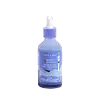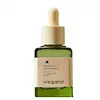What's inside
What's inside
 Key Ingredients
Key Ingredients

 Benefits
Benefits

 Concerns
Concerns

No concerns
 Ingredients Side-by-side
Ingredients Side-by-side

Water
Skin ConditioningPropanediol
SolventVinyldimethicone
Glycerin
HumectantDipropylene Glycol
HumectantHydrogenated Lecithin
EmulsifyingGlycolipids
Skin ConditioningHydroxyacetophenone
AntioxidantBisabolol
MaskingCetyl Ethylhexanoate
EmollientMacadamia Ternifolia Seed Oil
EmollientSorbitan Stearate
EmulsifyingSodium Acrylate/Sodium Acryloyldimethyl Taurate Copolymer
Emulsion StabilisingPolyisobutene
Niacinamide
SmoothingPEG-5 Rapeseed Sterol
CleansingPolyglyceryl-10 Laurate
Skin Conditioning1,2-Hexanediol
Skin ConditioningCholesterol
EmollientPhytosteryl/Behenyl/Octyldodecyl Lauroyl Glutamate
Skin ConditioningDimethicone/Vinyl Dimethicone Crosspolymer
Skin ConditioningBakuchiol
AntimicrobialButyrospermum Parkii Butter
Skin ConditioningRetinol
Skin ConditioningTocopherol
AntioxidantDisodium EDTA
Ceramide NP
Skin ConditioningAcrylates/C10-30 Alkyl Acrylate Crosspolymer
Emulsion StabilisingDipotassium Glycyrrhizate
HumectantSucrose Cocoate
EmulsifyingSodium Hyaluronate
HumectantPentaerythrityl Tetra-Di-T-Butyl Hydroxyhydrocinnamate
AntioxidantRosa Damascena Flower Water
MaskingCaprylyl/Capryl Glucoside
CleansingAdenosine
Skin ConditioningSorbitan Oleate
EmulsifyingCetearyl Alcohol
EmollientStearic Acid
CleansingVanilla Planifolia Fruit Extract
Skin ConditioningPolyglutamic Acid
Skin ConditioningTromethamine
BufferingCamellia Sinensis Leaf Extract
AntimicrobialBenzotriazolyl Dodecyl P-Cresol
UV AbsorberGlyceryl Stearate
EmollientPolyglyceryl-10 Myristate
Skin ConditioningOleic Acid
EmollientButylene Glycol
HumectantSantalum Album Oil
MaskingCaprylyl Glycol
EmollientEthylhexylglycerin
Skin ConditioningCeramide Ns
Skin ConditioningPhytosphingosine
Skin ConditioningCarbomer
Emulsion StabilisingArginine
MaskingCeramide As
Skin ConditioningCeramide AP
Skin ConditioningCentella Asiatica Leaf Extract
Skin ConditioningCentella Asiatica Root Extract
Skin ConditioningCentella Asiatica Extract
CleansingSodium Dna
Skin ConditioningCeramide EOP
Skin ConditioningAcetyl Hexapeptide-8
HumectantPalmitoyl Pentapeptide-4
Skin ConditioningCopper Tripeptide-1
Skin ConditioningAsiatic Acid
Skin ConditioningAsiaticoside
AntioxidantMadecassic Acid
Skin ConditioningMadecassoside
AntioxidantWater, Propanediol, Vinyldimethicone, Glycerin, Dipropylene Glycol, Hydrogenated Lecithin, Glycolipids, Hydroxyacetophenone, Bisabolol, Cetyl Ethylhexanoate, Macadamia Ternifolia Seed Oil, Sorbitan Stearate, Sodium Acrylate/Sodium Acryloyldimethyl Taurate Copolymer, Polyisobutene, Niacinamide, PEG-5 Rapeseed Sterol, Polyglyceryl-10 Laurate, 1,2-Hexanediol, Cholesterol, Phytosteryl/Behenyl/Octyldodecyl Lauroyl Glutamate, Dimethicone/Vinyl Dimethicone Crosspolymer, Bakuchiol, Butyrospermum Parkii Butter, Retinol, Tocopherol, Disodium EDTA, Ceramide NP, Acrylates/C10-30 Alkyl Acrylate Crosspolymer, Dipotassium Glycyrrhizate, Sucrose Cocoate, Sodium Hyaluronate, Pentaerythrityl Tetra-Di-T-Butyl Hydroxyhydrocinnamate, Rosa Damascena Flower Water, Caprylyl/Capryl Glucoside, Adenosine, Sorbitan Oleate, Cetearyl Alcohol, Stearic Acid, Vanilla Planifolia Fruit Extract, Polyglutamic Acid, Tromethamine, Camellia Sinensis Leaf Extract, Benzotriazolyl Dodecyl P-Cresol, Glyceryl Stearate, Polyglyceryl-10 Myristate, Oleic Acid, Butylene Glycol, Santalum Album Oil, Caprylyl Glycol, Ethylhexylglycerin, Ceramide Ns, Phytosphingosine, Carbomer, Arginine, Ceramide As, Ceramide AP, Centella Asiatica Leaf Extract, Centella Asiatica Root Extract, Centella Asiatica Extract, Sodium Dna, Ceramide EOP, Acetyl Hexapeptide-8, Palmitoyl Pentapeptide-4, Copper Tripeptide-1, Asiatic Acid, Asiaticoside, Madecassic Acid, Madecassoside
Water
Skin ConditioningDipropylene Glycol
HumectantGlycerin
Humectant1,2-Hexanediol
Skin ConditioningBakuchiol
AntimicrobialTrehalose
HumectantTocopherol
AntioxidantHelianthus Annuus Seed Oil
EmollientSodium Hyaluronate
HumectantSqualane
EmollientPalmitoyl Tripeptide-5
Skin ConditioningC12-14 Pareth-12
EmulsifyingHydroxyethyl Acrylate/Sodium Acryloyldimethyl Taurate Copolymer
Emulsion StabilisingAcrylates/C10-30 Alkyl Acrylate Crosspolymer
Emulsion StabilisingTromethamine
BufferingEthylhexylglycerin
Skin ConditioningDisodium EDTA
Sorbitan Isostearate
EmulsifyingWater, Dipropylene Glycol, Glycerin, 1,2-Hexanediol, Bakuchiol, Trehalose, Tocopherol, Helianthus Annuus Seed Oil, Sodium Hyaluronate, Squalane, Palmitoyl Tripeptide-5, C12-14 Pareth-12, Hydroxyethyl Acrylate/Sodium Acryloyldimethyl Taurate Copolymer, Acrylates/C10-30 Alkyl Acrylate Crosspolymer, Tromethamine, Ethylhexylglycerin, Disodium EDTA, Sorbitan Isostearate
Ingredients Explained
These ingredients are found in both products.
Ingredients higher up in an ingredient list are typically present in a larger amount.
1,2-Hexanediol is a synthetic liquid and another multi-functional powerhouse.
It is a:
- Humectant, drawing moisture into the skin
- Emollient, helping to soften skin
- Solvent, dispersing and stabilizing formulas
- Preservative booster, enhancing the antimicrobial activity of other preservatives
Acrylates/C10-30 Alkyl Acrylate Crosspolymer is a synthetic polymer. It is used to thicken and improve the texture of products. Due to its properties, it can prevent water and oil ingredients from separating.
Bakuchiol is a plant-derived antioxidant (it's vegan!). It is often called the replacement for retinol although it is not part of the same family.
It has similar effects as retinol: skin smoothing, reducing discoloration, and preventing wrinkles. It does not cause as much irritation as traditional retinoids.
Bakuchiol works by breaking down free radicals and stimulating collagen production in skin.
Combining bakuchiol with retinol will not have adverse side effects. Studies show using them will just boost the benefits. Bakuchiol is also found to help stabilize retinol.
While bakuchiol does not make the skin more sun sensitive, we recommend wearing SPF on a daily basis.
Read more about traditional retinol
Learn more about BakuchiolDipropylene Glycol is a synthetically created humectant, stabilizer, and solvent.
This ingredient helps:
Dipropylene glycol is technically an alcohol, but it belongs to the glycol family (often considered part of the ‘good’ alcohols). This means it is hydrating and gentle on skin unlike drying solvent alcohols like denatured alcohol.
As a masking agent, Dipropylene Glycol can be used to cover the smell of other ingredients. However, it does not have a scent.
Studies show Dipropylene Glycol is considered safe to use in skincare.
Learn more about Dipropylene GlycolDisodium EDTA plays a role in making products more stable by aiding other preservatives.
It is a chelating agent, meaning it neutralizes metal ions that may be found in a product.
Disodium EDTA is a salt of edetic acid and is found to be safe in cosmetic ingredients.
Learn more about Disodium EDTAEthylhexylglycerin (we can't pronounce this either) is commonly used as a preservative and skin softener. It is derived from glyceryl.
You might see Ethylhexylglycerin often paired with other preservatives such as phenoxyethanol. Ethylhexylglycerin has been found to increase the effectiveness of these other preservatives.
Glycerin is already naturally found in your skin. It helps moisturize and protect your skin.
A study from 2016 found glycerin to be more effective as a humectant than AHAs and hyaluronic acid.
As a humectant, it helps the skin stay hydrated by pulling moisture to your skin. The low molecular weight of glycerin allows it to pull moisture into the deeper layers of your skin.
Hydrated skin improves your skin barrier; Your skin barrier helps protect against irritants and bacteria.
Glycerin has also been found to have antimicrobial and antiviral properties. Due to these properties, glycerin is often used in wound and burn treatments.
In cosmetics, glycerin is usually derived from plants such as soybean or palm. However, it can also be sourced from animals, such as tallow or animal fat.
This ingredient is organic, colorless, odorless, and non-toxic.
Glycerin is the name for this ingredient in American English. British English uses Glycerol/Glycerine.
Learn more about GlycerinSodium Hyaluronate is hyaluronic acid's salt form. It is commonly derived from the sodium salt of hyaluronic acid.
Like hyaluronic acid, it is great at holding water and acts as a humectant. This makes it a great skin hydrating ingredient.
Sodium Hyaluronate is naturally occurring in our bodies and is mostly found in eye fluid and joints.
These are some other common types of Hyaluronic Acid:
Learn more about Sodium HyaluronateTocopherol (also known as Vitamin E) is a common antioxidant used to help protect the skin from free-radicals and strengthen the skin barrier. It's also fat soluble - this means our skin is great at absorbing it.
Vitamin E also helps keep your natural skin lipids healthy. Your lipid skin barrier naturally consists of lipids, ceramides, and fatty acids. Vitamin E offers extra protection for your skin’s lipid barrier, keeping your skin healthy and nourished.
Another benefit is a bit of UV protection. Vitamin E helps reduce the damage caused by UVB rays. (It should not replace your sunscreen). Combining it with Vitamin C can decrease sunburned cells and hyperpigmentation after UV exposure.
You might have noticed Vitamin E + C often paired together. This is because it is great at stabilizing Vitamin C. Using the two together helps increase the effectiveness of both ingredients.
There are often claims that Vitamin E can reduce/prevent scarring, but these claims haven't been confirmed by scientific research.
Learn more about TocopherolTromethamine helps balance the pH and improve the texture of a product. It is synthetically created.
As an emulsifier, Tromethamine prevents oil and water ingredients from separating. This helps stabilize the product and elongate a product's shelf life. Tromethamine also makes a product thicker.
Tromethamine helps balance the pH level of a product. Normal pH level of skin is slightly acidic (~4.75-5.5). The acidity of our skin is maintained by our glands and skin biome. Being slightly acidic allows our skin to create an "acid mantle". This acid mantle is a thin barrier that protects our skin from bacteria and contaminants.
Oral Tromethanmine is an anti-inflammatory drug but plays the role of masking, adding fragrance, and/or balancing pH in skincare.
1,3-Propanediol, 2-amino-2-(hydroxymethyl)-
Learn more about TromethamineWater. It's the most common cosmetic ingredient of all. You'll usually see it at the top of ingredient lists, meaning that it makes up the largest part of the product.
So why is it so popular? Water most often acts as a solvent - this means that it helps dissolve other ingredients into the formulation.
You'll also recognize water as that liquid we all need to stay alive. If you see this, drink a glass of water. Stay hydrated!
Learn more about Water